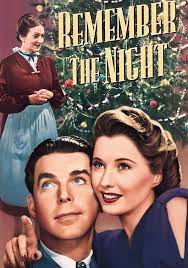What is the place of love in bioethics?
Mitchell Leisen's Remember the Night (1940)

In 1940, Mitchell Leisen released Remember the Night, with a screenplay by Preston Sturges. It was the last collaboration between the two geniuses. The discursive force of Sturges’ writing was subjected to Leisen’s style, not without some protests from the screenwriter. The result was optimal. Leisen had, like a few others, the ability to convey what he wanted to convey in a visual and synthetic way. He sought to get to the heart of the story he was telling. He connected with the sensibility of the audience. We have already seen this on this page in two of his films[1]. In addition, his films were in principle conceived as entertainment films. With humour, the director pointed out that he did not send messages, as that was what the telegraph service was for. Rather, these words should be interpreted as meaning that he was not looking for a cinema that would send out slogans. To entertain intelligently, one has to reach, in Dietrich von Hildebrand’s expression, the fine affectivity, the core of the heart. He masterfully achieved this throughout his career, and especially in this film. It nurtures bioethical reflection on the urgent need to recognise the personal presence of victims who are so easily discarded.
What were the differences between Sturges’ conception and what Leisen finally shot? The publication of the screenplay of Remember the Night, edited by Andrew Horton, clarifies many things[2]. To begin with, the name of the film in the original script was The Amazing Marriage. Leisen – we don’t know if Paramount Studios intervened – opted for a different name that put the focus in a different direction. Sturges opted for the conflict arising from the antagonistic roles of the characters, Lee Leander (Barbara Stanwyck) and John Sargent (Fred McMurray): positions before the law (a thief / a prosecutor), moral attitudes (naughtiness/innocence), or even between personal processes (conversion of the thief who begins by recognising her crime/corruption of the prosecutor who forgets his duties).
Instead, Leisen let the camera capture the mystery surrounding the love that had arisen in the characters. As if inviting the viewers to discover something that seems new each time the film is watched. Beyond all the oppositions and antagonisms, the unitive and transformative power of mutual love was proposed. Lee Leander and John Sargent showed that the true love that had arisen between them had a solid common ground. It had overturned their securities. It had humbled them. They were able to see something that was far above them.
The force of love breaks down the wall of human laws: the plot of Remember the Night.
And almost as if in passing, Leisen was proposing something of complete interest for bioethical reflection: the power of love is capable of breaking down the walls created by legislation because it allows the unique and unrepeatable value of each human person to be recognised. And it did so, as so often happened in the best classic Hollywood, by proposing the Christmas atmosphere, the most propitious for people to bring out the only language that keeps them in their being and in their vocation: the language of gift, of surrender and of hope. A petty thief, Lee Lander, is discovered selling the bracelet she has just stolen from a high-class jeweler’s shop in a pawnshop. The prosecutor, John Sargent, seeing the “peace in the world” look in the jury, typical of the Christmas season, gets a continuance to prevent her acquittal. But he realises that his strategy will land the young woman in jail on such an important day. He takes pity on her and pays her bail. She is taken home thinking he was looking for dirt on her, but Sargent has only wanted to treat her like a human being. Realising she has nowhere else to go, he invites her to dinner and pays for a hotel. However, their conversation, as they dance, reveals that they are from the same state, Indiana, less than fifty miles apart. As John is driving to spend the holidays with his mother, he invites her to join him. Again with total cleanliness.
Lee Leander fears that her mother won’t take her in, because she ran away from home. And she is right. The scene is terrible. The mature woman’s coldness and resentment towards her daughter is such that the prosecutor chooses to remove her from that environment and take her to the home of his mother (Beulah Bondi) and aunt (Elizabeth Patterson). There, the young girl experiences what a loving home is like, and is truly transformed. Mrs. Sargent, when her son confesses to her that Lee is a thief, says: “Surely she didn’t have enough love in her childhood. And she reminds her son that as a child he also stole something from her, who gave him the opportunity for repentance and reparation. “You made me understand,” John points out. “No, honey. Love made you understand,” Mrs. Sargent points out.
John, by keeping Lee out of jail in those days, had already seen her as a person. By witnessing the rejection Lee had received from her mother, she had grown in involvement. Sensing how the atmosphere of the Sargent home had filled her with serenity, those feelings took a definite step towards mutual infatuation. What he could not expect was to find in her a reciprocity that was even to surpass him. Mrs. Sargent warns Lee that her son has fallen in love with her, and that he would throw away his career, just to get her off the hook. But the young woman, when the trial arrives, pleads guilty so that this will not happen. John, desperate to lose her, asks her to marry him, before the conviction is known. Lee doesn’t accept either. She prefers him to wait until she is free so that he can be sure of his feelings.
The film ends without us knowing what the verdict is. It is announced for three days later. Lee, who will have to wait for him in prison, only asks John: “Will you stand by me and hold my hand when the sentence is read? The young man answers without hesitation with “Of course I will” and the last words on the tape are Lee’s: “Then I won’t be afraid. I love you so much. Leisen does not leave the viewer in front of what could have been a “mind-blowing marriage”. He wants the viewer to look at the true foundation of any marriage, true love: being able to give oneself unreservedly, recognising the genuine dignity of the other person.
Presence is something that is immediately and irrecusably revealed in a look, a smile, an accent, a handshake.
A quote from Gabriel Marcel can illuminate our reading of Remember The Night.
It is a fact of irrecusable experience, but of which it is difficult to give an intelligible translation, that there are certain beings who reveal themselves to us as present, that is to say, as available when we suffer, when we need to confide in them, and that there are others who do not give us this feeling despite their possible goodwill […] Presence is something that reveals itself immediately and irrecusably in a look, in a smile, in an accent, in a handshake (Presence, in short, is made manifest in a luminous way in the available being).
I would say, to clarify all this, that the available being is that being capable of being fully with me when I need it; the unavailable being, on the other hand, is that which seems to operate in my favour in a sort of momentary attribution in the totality of the resources at my disposal. For the former I am a presence, for the latter an object. Presence implies a reciprocity that undoubtedly excludes any relation of subject to object or of subject to subject-object.[3] It is only when we are able to make ourselves available to the other that we are able to make ourselves available to the other.
Only when we are able to make ourselves available, to involve ourselves, do we recognise the other as a person. But this does not happen automatically. It requires a deep education in true feelings. Remember the Night looks like a master class in this education of feelings. The lawyer defending Lee, Francis O’Leary (Willard Robertson), gives the jury such a complete theatrical performance of Lee as a victim that the jury is moved. But when his ruse fails and the trial is postponed, he doesn’t lift a finger to keep the young woman out of prison. Quite the opposite of the prosecutor, as we have narrated.
In contrast to the lawyer’s false sentimentality, Leisen depicts Sargent’s growth in readiness that leads him to recognise Lee’s presence. She, in turn, shows a genuine availability towards John, which allows her to recognise his presence and to reject with horror any instrumentalisation of him.
In pre-war times – the film is a few months before Arise My Love – Leisen was still committed to his films bringing to the spectators that moral beauty which should guard in their hearts the civilisation of love and life against the growth of barbarism. Today, our eyes also swell with horror when we see the innocent victims in Israel, in the Gaza Strip, or in the painful annihilation of Indi Gregory[4]. And in the wake of what Mitchell Leisen intended, we need other representations of human reality to free our sensibility and our conscience from the tyranny of horror that too many current opinions would have us believe we are doomed to.
Quite the contrary. As Marcel pointed out, the memory of so many innocent victims is not that of an object that we can forget, but that of a presence that continues to encourage us. Because we cannot help thinking and sensing that they remain mysteriously alive and encouraging in us the memory of the best, so that evil does not have the last word.
Preston Sturges constructed a magnificent story, but perhaps he remained at the level of tolerance or paradox. He explained synthetically that his screenplay showed that what was meat to some was poison to others. With Mitchell Leisen the narrative moves beyond the disputes between norms, laws or social roles. It shows that there is a core of reconciliation that allows us to receive with full hands the gift of love and availability to people. A key experience for sustaining love in bioethics in the face of horror.
José-Alfredo Peris-Cancio – Professor and researcher in Philosophy and Film – Universidad Católica de Valencia San Vicente Mártir
[1] Arise My Love (1940), https://www.observatoriobioetica.org/2023/10/adelante-mi-amor-la-unificacion-de-vida-como-verdadero-combustible-de-la-bioetica/42676 and The Lady is Willing (1942), https://www.observatoriobioetica.org/2023/11/lo-fragil-nos-hace-responsables-una-invitacion-a-la-bioetica-desde-capricho-de-mujer-de-mitchell-leisen/42794
[2] Sturges, P. (1998). Three More Screenplays by Preston Sturges: The Power and the Glory, Easy Living, Remember the Night; edited with introductions by Andrew Horton; foreword by Tom Sturges. Berkeley and Los Angeles, California; London, England: University of California Press, pp. 1-20; 315-491.
[3] Gabriel Marcel, Aproximación al misterio del Ser, Encuentro, Madrid: pp. 71-72.
[4] See the article by Julio Tudela and Ester Bosch on this same page, https://www.observatoriobioetica.org/2023/11/la-justicia-britanica-impide-a-los-padres-de-indi-gregory-retirarle-el-soporte-vital-en-casa/42859

Related

Divine Mercy, the Small and the Great
José María Montiu de Nuix
27 April, 2025
5 min

Reversing Social Deterioration: A Task That Begins in Business Management
Alejandro Fontana
25 April, 2025
4 min

The Revolution of Tenderness
María Elizabeth de los Ríos
25 April, 2025
3 min

His Hope Does Not Die!
Mario J. Paredes
24 April, 2025
6 min
 (EN)
(EN)
 (ES)
(ES)
 (IT)
(IT)

